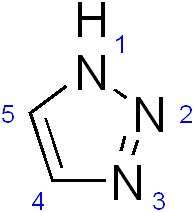September 16, 2011 report
Chemists figure out a way to force apart click chemistry bonds

(PhysOrg.com) -- Normally when chemists think of methods to urge chemical reactions, brute force is not really very high on the list; while such techniques might be useful for breaking apart materials, i.e. bashing cement to get smaller pieces of cement; it’s generally not been a useful way to tear apart the molecules that actually comprise the compound itself. At least till now. Christopher Bielawski and colleagues at the University of Texas, as described in their paper in Science, have figured out a way to unbind triazole to get back its original components azide and alkyne, using nothing but force.
Triazole is a ring shaped chemical compound that is formed during the reaction that occurs between azide and alkyne when mixed with copper. Its formation is considered to be a type of “click” or snap-together chemistry reaction due to the fact that the components click together in a very tight formation; sort of like wooden floor panels that click together to keep from sliding apart under constant abuse from foot traffic. Such bonds once formed have traditionally been very difficult to force apart, even under intense heat. Now however, Bielawski and his team have figured out a way to do it using brute force.
To pull the components of triazole apart, the team attached polymer chains to either side of the individual molecules, then immersed them in a solution and applied ultrasound. Doing so caused tiny bubbles to form of a certain size that soon collapsed, leaving a vacuum behind. The vacuum force then pulled the components of the molecule apart by yanking on the polymer chains. The end result is azide and alkyne, the original components in their original forms.
The experiment is the first of its kind, showing that such compounds can be torn apart by force, opening the door to all kinds of other possibilities where researchers wish to be able to take compounds apart piece by piece without impacting anything else in the surrounding environment.
In their paper the team points out that such types of forced reactions might already be taking place in nature leading to failures of materials in previously unexplainable ways; or worse in pharmaceuticals that break down in the body leading to perhaps dangerous consequences.
Looking towards the future, this new method of tearing apart chemical bonds might lead to new types of sensors that can detect stress or be used as a type of “bodyguard” for other compounds that can be taken apart and removed when its usefulness has run its course.
More information: Unclicking the Click: Mechanically Facilitated 1,3-Dipolar Cycloreversions, Science 16 September 2011: Vol. 333 no. 6049 pp. 1606-1609. DOI: 10.1126/science.1207934
ABSTRACT
The specific targeting of covalent bonds in a local, anisotropic fashion using mechanical methods offers useful opportunities to direct chemical reactivity down otherwise prohibitive pathways. Here, we report that embedding the highly inert 1,2,3-triazole moiety (which is often prepared using the canonical “click” coupling of azides and alkynes) within a poly(methyl acrylate) chain renders it susceptible to ultrasound-induced cycloreversion, as confirmed by comprehensive spectroscopic and chemical analyses. Such reactivity offers the opportunity to develop triazoles as mechanically labile protecting groups or for use in readily accessible materials that respond to mechanical force.
© 2011 PhysOrg.com
















